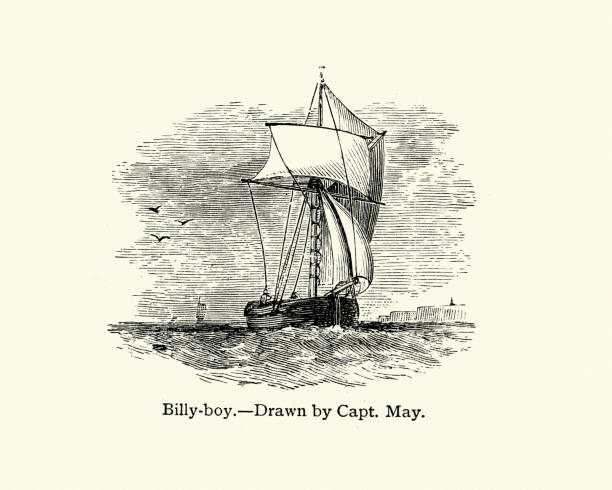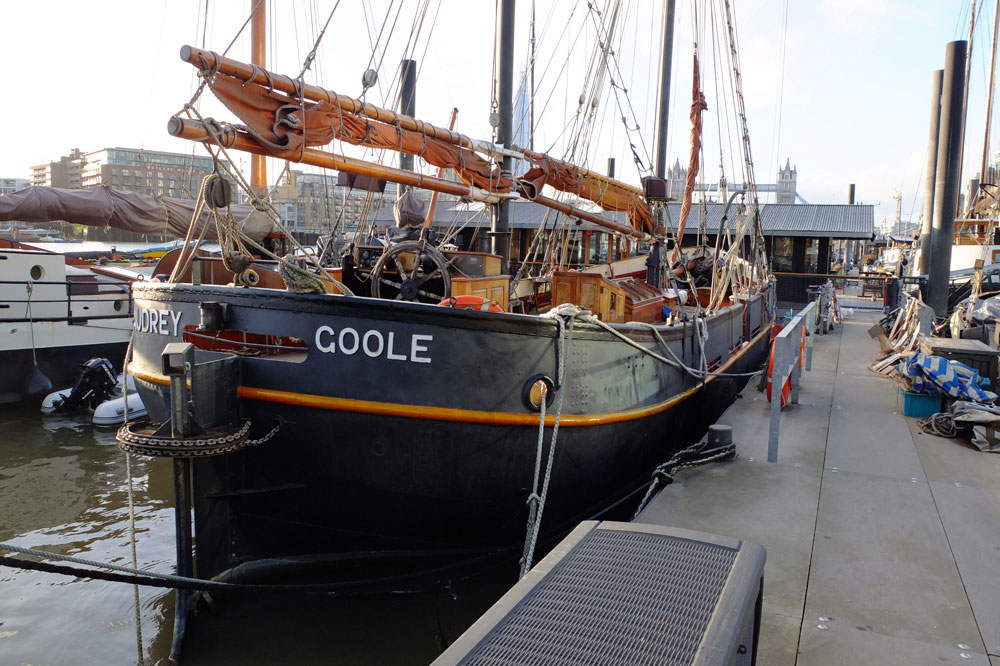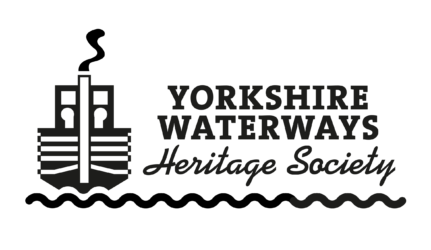Waterways historian Steve Gardham writes about an unusual class of waterways vessel found in Yorkshire, the Billy Boy. This type of craft was able to not only navigate Yorkshire’s rivers, canals and the Humber but significantly also take to the open sea to visit coastal ports around England.
First of all I must stress that my researches into the murky history of this coastal/inland vessel are ongoing and far from complete. The earliest record of a billy boy I currently have is of the Apollos built at Knottingley in 1817 and rigged as a sloop. Perhaps it is no coincidence that having checked all of my records of 97 billy boys the greatest number were built at Knottingley and the most common rig is sloop. I can find no references earlier than this, and indeed if you look at the many paintings of the Humber and its vessels from the late eighteenth and early nineteenth centuries, without fail all of the vessels of this size and build fly the Dutch flag, i.e., they are herring busses, bijlanders and hoys.

So what are billy boys and what makes them so hard to identify in the records such as the registration ledgers? On the face of it their origin as a river and coastal craft would have been as a natural development of the Humber keel. They have the same boxlike hull with sheer sides, but as one would expect somewhat bigger than the keel at around 50 tons, billy boys ranging from about 60 to 120 tons. Billy boys are characterised by their complete bulwarks, but some of the smaller ketch-rigged vessels had gaps along the sides to allow for easier transfer of cargoes. Many of the smaller billy boys also had the same leeboards that the sloops and keels had, and like the sloops and keels they could unship the masts and rigging when navigating inland.

The greater portion of these vessels were sloop-rigged, and it is probable that the earliest ones were, but a sizable proportion of them were ketch-rigged and schooner-rigged, and it was fairly common for some vessels to change their rig from one to the other as trade demanded. A few were also cutter-rigged but these later became sloop-rigged. The following table gives an idea of the relative numbers though I don’t have information on the rigs of all of them yet.
Sloop——————35
Schooner————–19
Ketch——————14
Ketch/Schooner——5
Ketch/Sloop———–4
Cutter——————-2
Cutter/Sloop———–3
Sloop/Ketch/Schooner–1

The main problem in identifying billy boys is that during the nineteenth century the most common way of identifying vessels of this size in the registers was by their rig rather than their build, so that Lloyds Registers and local registers only tell us cutter/sloop/ketch/schooner, and in these it is impossible to distinguish a billy boy from another vessel type. The best places to glean information from are books and newspaper reports and adverts. Unfortunately the books are all written after the demise of these vessels, twentieth century writers reminiscing, and many of these are written about the east coast trade in general. Books on Humber keels also contain some information.
Now we come to the controversial subject of where the name came from. Whilst admitting we simply do not know, most twentieth century writers plump for the idea that billy boys were Hull vessels and that Hull watermen were great supporters of William III, King Billy, at the beginning of the eighteenth century, and because of that they tell us Hull men were known as Billy Boys, i.e., the followers of King Billy whose gold-covered statue rides above the toilet block in the old Market Place (now Lowgate) in Hull, and hence the name somehow got transferred to typical Hull vessels. This is a plausible theory, but as we shall see these vessels were more from the inland ports than from Hull, though no doubt they all visited Hull as the major port in the region, and many were registered at Hull even when not built there.
Looking at all the 97 I have details on, in fact only 5 were built at Hull, and indeed most were built in a remarkably wide range of places, some far inland. Knottingley has the most at 15 with Goole a close second at 12 and then Wakefield with 7. Leeds and Barton come in with 4 each then Thorne with 3. Stainforth and Mexborough both have 2, and indeed after 1900, 2 were built in Holland. The rest only have a single example. As one would expect the inland towns on the Humber basin feature here, Winteringham, Allerton, Hessle, York, Beverley, Selby, Masbro, Burton Stather, Howden and Worsbrodale. Lincoln and Louth feature and then moving down the coast, Boston, Wisbech, Ely, Wells, Yarmouth, Southwold, Fingringhoe and Maldon. This is no surprise as the regular route of the billy boys was down the east coast to the Thames and even into the Channel. I have a photo of one leaving Bridlington harbour but they don’t appear to have ventured further north much, although I’ve seen records of some being wrecked off the coast of Scotland. The larger brigs dominated the coast trade beyond Bridlington, but those pictures I have seen of the collier brigs in Whitby and on the Tyne and Tees, look remarkably like larger versions of the billy boys with similar lines.

This brings me to my theory on how the name could have originated. The closest vessel in size, shape and trade is the Dutch bijlander (by-land, i.e., coast and inland) with also a nod perhaps to the hoy. The shortening of words so typical of sea and rivermen would easily bring ‘billander’ to ‘billy’, and ‘hoy’ is not a million miles from ‘boy’, hence billy boy. Any maritime historian is well aware of our indebtedness to the Dutch for many of our naval designs, drainage, maritime practices, etc. There is even a little irony in that two of the last billy boys to be built were built in Holland.
As I have mentioned, very little useful information survives from the billy boy period, roughly the century from 1815 to 1915, other than what can be gleaned from newspapers. There are three fairly well-known exceptions, the most famous perhaps being E. W. Cooke’s sketch of a sloop billy boy discharging her cargo at a quayside in Shoreham Harbour. Another depicts a topsail schooner-rigged billy boy sailing on the Thames in 1824, and a third shows a beached billy boy on the banks of the Thames, notably none of them on the Humber
The only surviving model of a billy boy I know of is owned by the Science Museum, one of the last to be built, the Aimwell, built at Winteringham in 1883 by Routh and Waddingham. It was one of those that went from ketch rig to schooner. The plans for the original, a set of only two known, are at the Caird Library of Greenwich Maritime Museum, but kept at Woolwich and difficult to access. About 10 years ago Hull Maritime Museum borrowed the model and had it on display. Unfortunately at the time I assumed that the Museum owned it and it was on permanent display, but was aghast when it disappeared and was told it had gone back to the Science Museum and wasn’t likely to come back any time soon. The other set of plans are of the Halcyon, built by Henry Scarr at Hessle in 1903, also at Woolwich.
What about survivals? When the Humber Keel and Sloop Preservation Society first formed, apart from preserving a keel and a sloop, they had plans to preserve a billy boy and started a search for a suitable vessel. However, those they found were in too bad a state to restore. Brilliant Star built in 1904 was still around but had been sadly neglected for too long so its preservation was not viable. Mavis had been converted to a steam barge but had been scrapped in the 60s. Similarly Halcyon was broken up in 1966. The only remaining true billy boy Saira is currently for sale on the south coast; a steel billy boy, she now has a steel superstructure and would take a lot of conversion to get her back to original state. That brings us to Audrey, originally a Whitton Sands lightship. She was acquired by The Sobriety Project in the 70s. Her hull was pretty much the shape and size of a billy boy so the project members decided to give her a billy boy conversion with a ketch rig. Unfortunately the project experienced financial difficulties and sold her into private ownership and she has spent the last 20 years on the Thames moored outside Katherine Dock.


Over the past five years I have spent many hours researching records to find more information on these vessels and acquiring photos of them. From time to time I will add in here snippets of extra information as they come to hand.
A typical round voyage would have been to load coal for Plymouth, return with china clay to the Thames and then sail for the Humber with cement. Sometimes a voyage was made with shingle ballast, for unlike spritsail barges the billy boys could not sail with an empty hold. Coal was taken into many small harbours and on to open beaches. They went up as far as Bridlington and along the coast south and into the Channel, even as far as Holland, Belgium and Germany. They produced fine sailors, some of whom later manned bigger vessels. Captain Woodget, a master of the Cutty Sark, started his career on a Norfolk billy boy. The larger old wooden billy boys were the biggest clinker-built craft in Europe.
Eventually I hope to produce a database of all the billy boys I have records for. Any further information, photos, pictures of these greatly neglected vessels would be very welcome.
Steve Gardham, Hull, Secretary, Yorkshire Waterways Heritage Society

One Comment
Christopher
There is a reference to the Goole billy-boy in Frank T Bullen’s “the cruise of the ‘cachalot’”